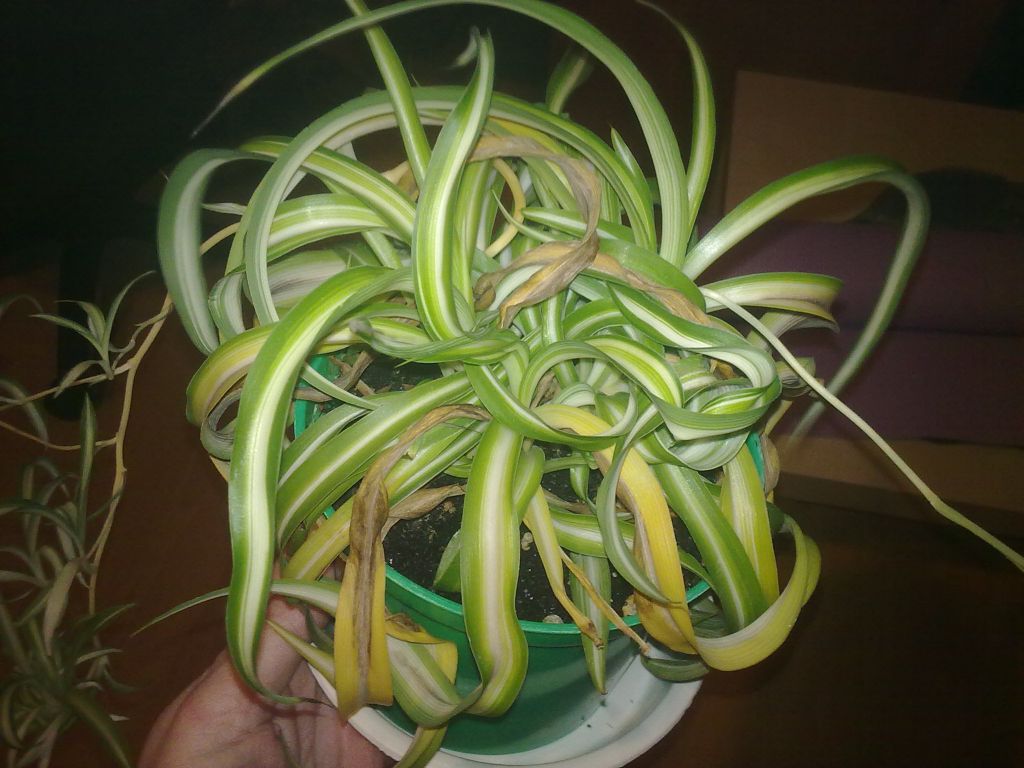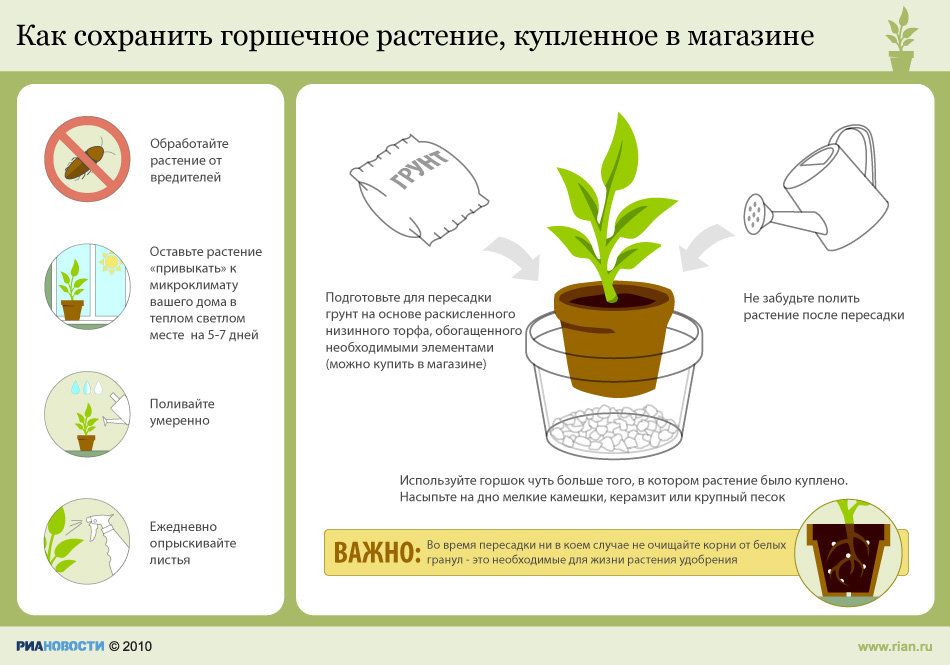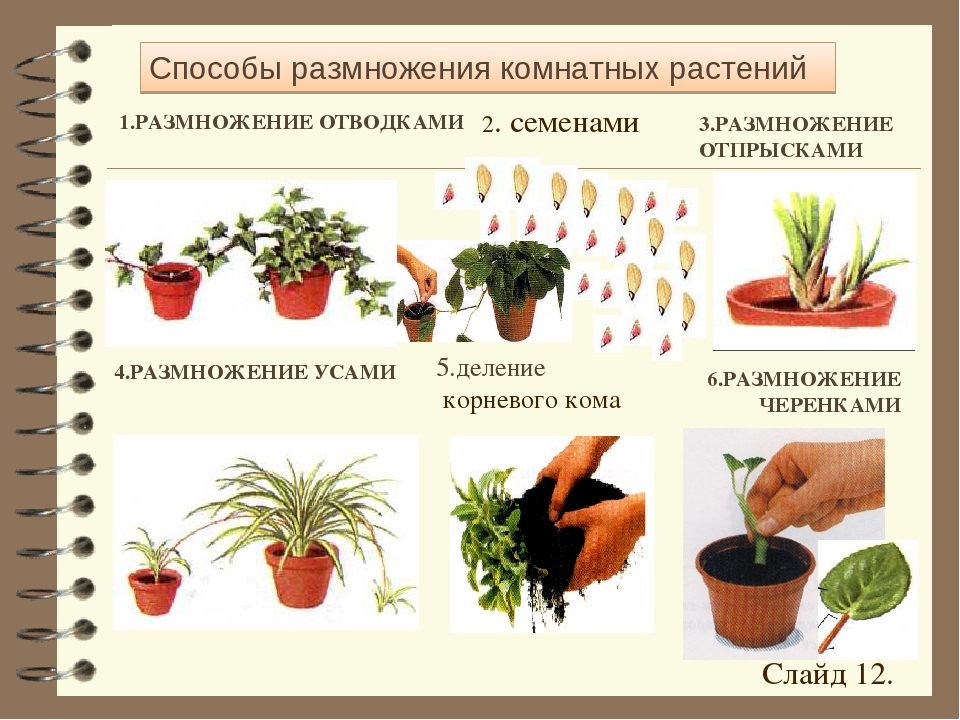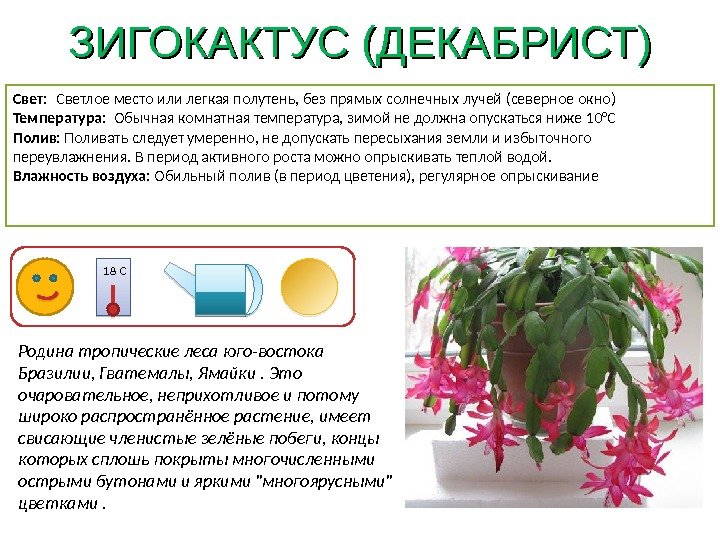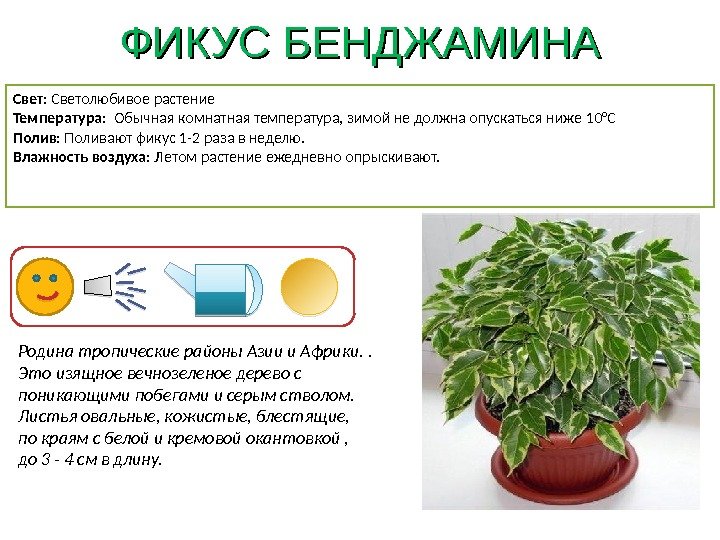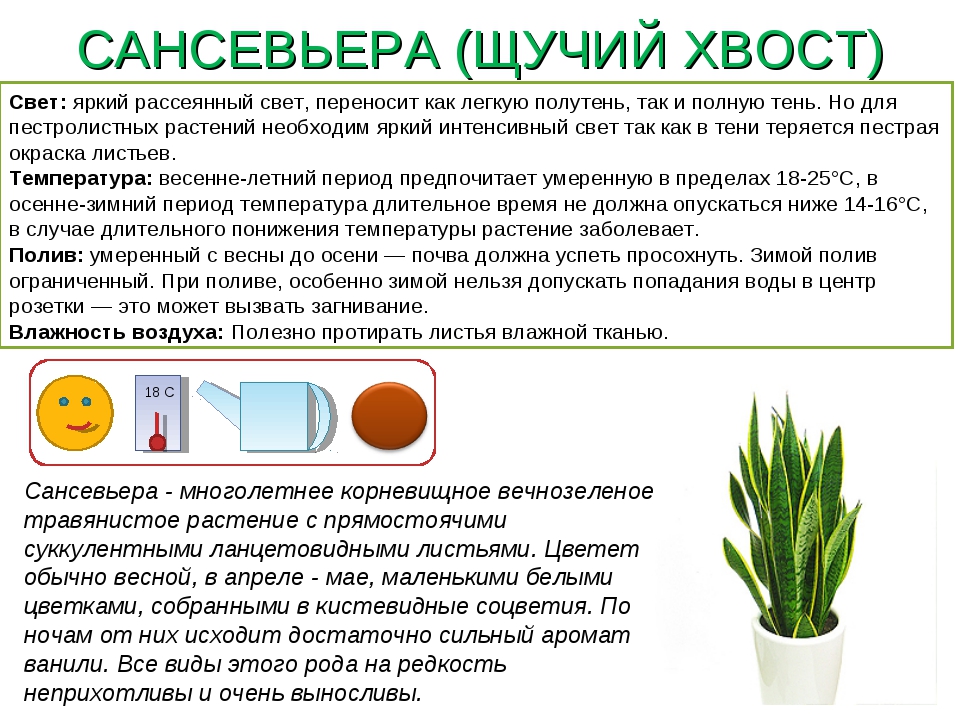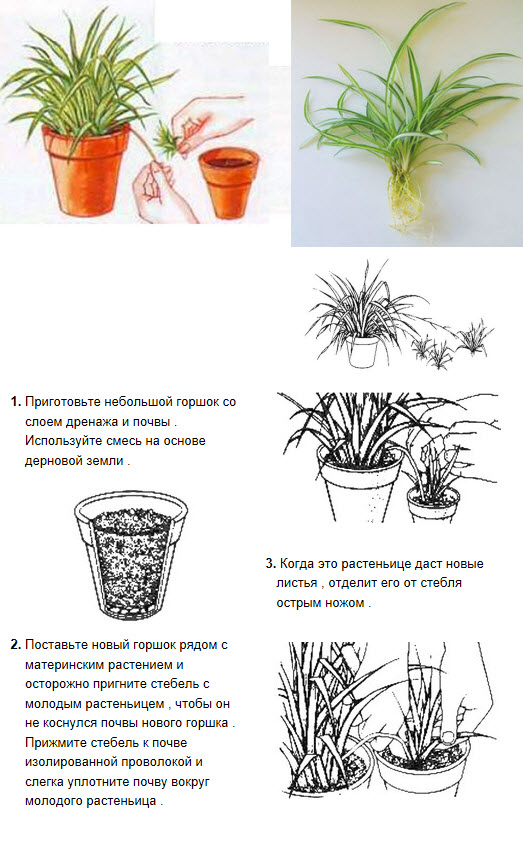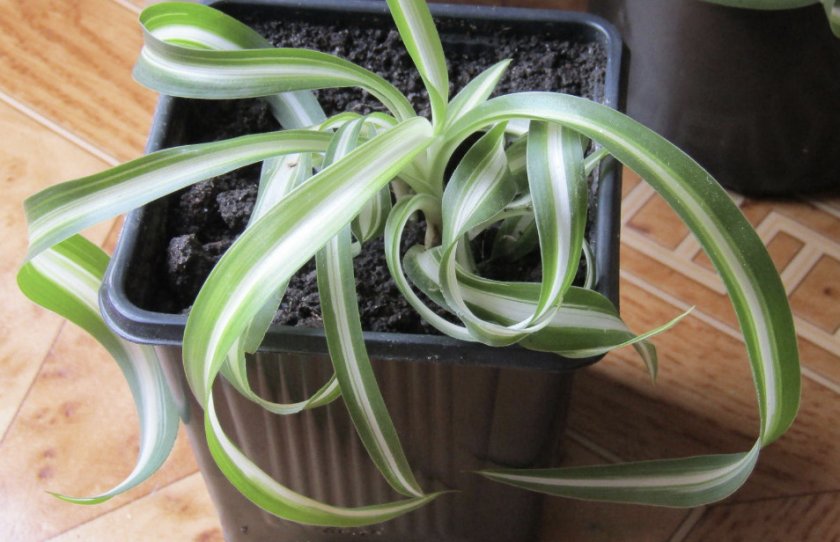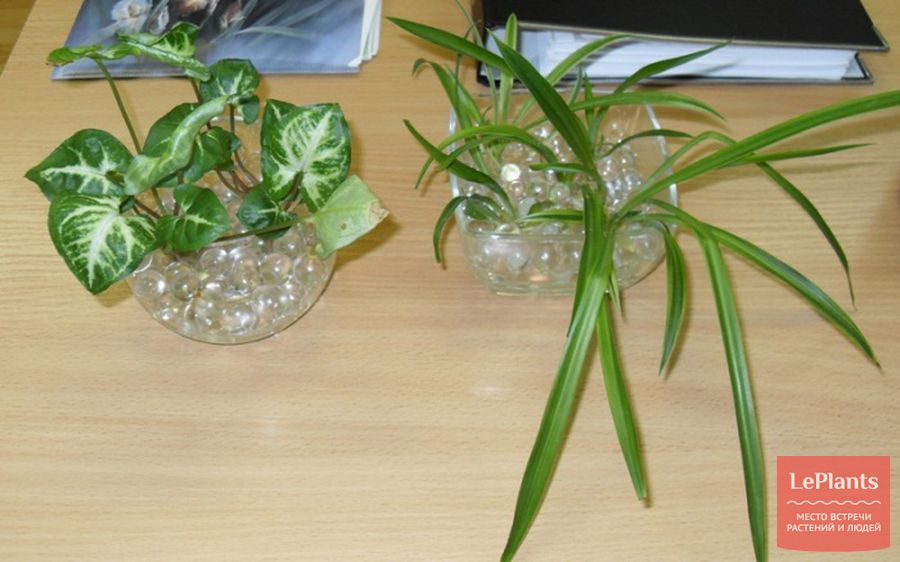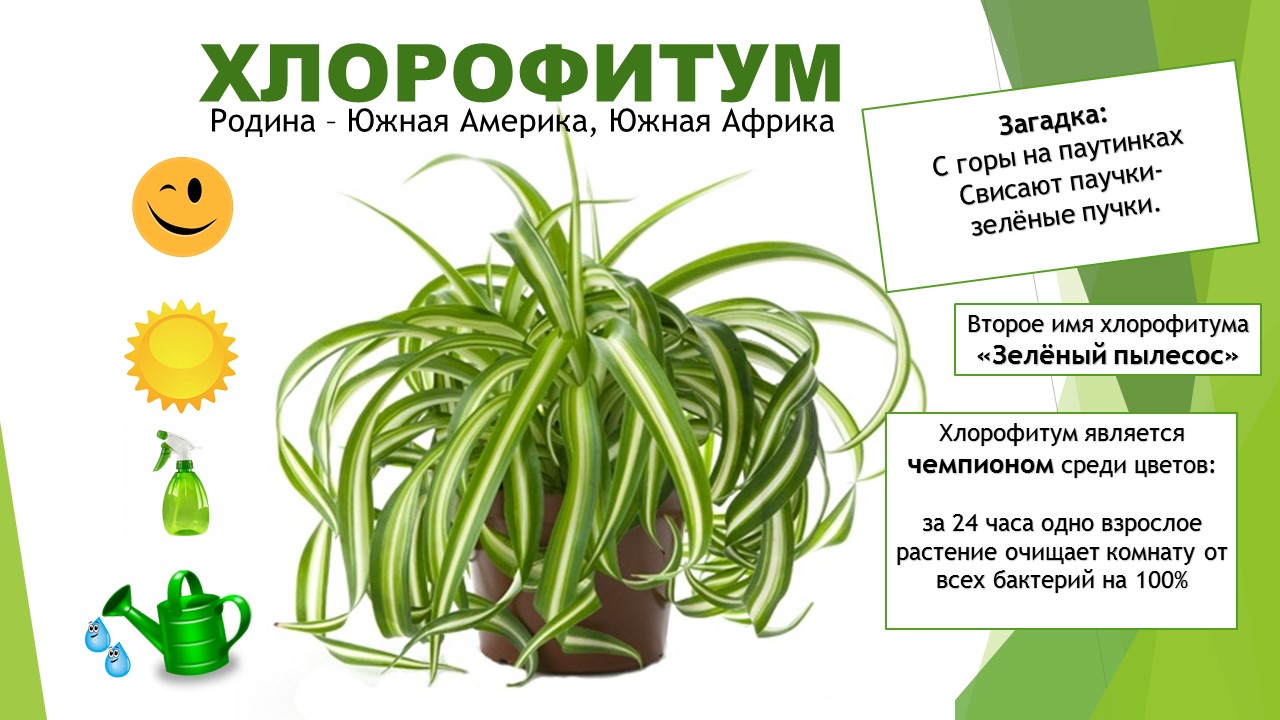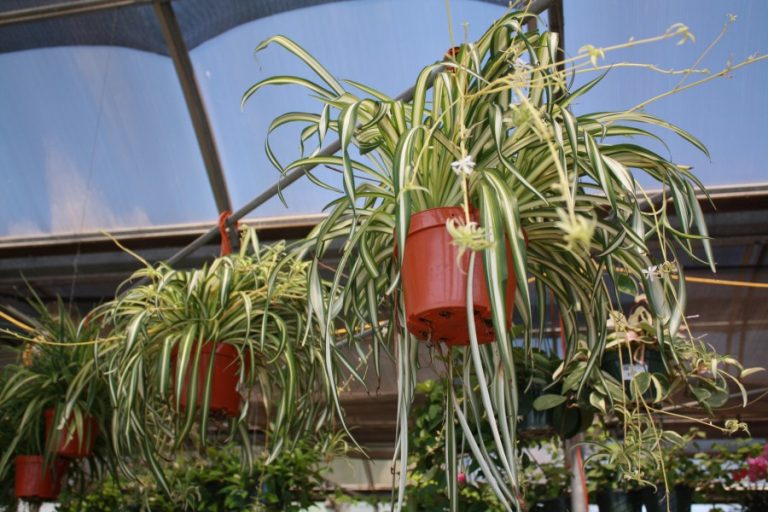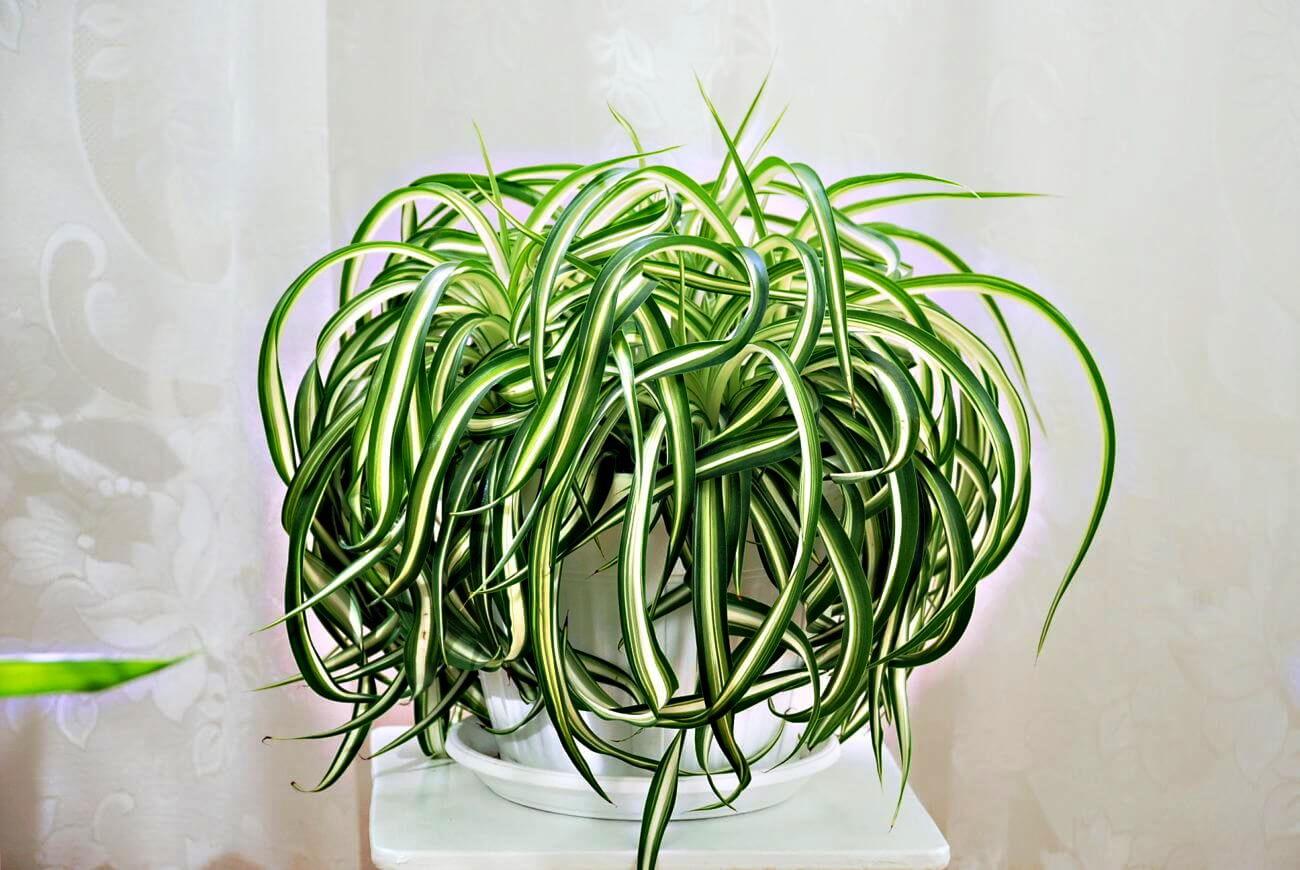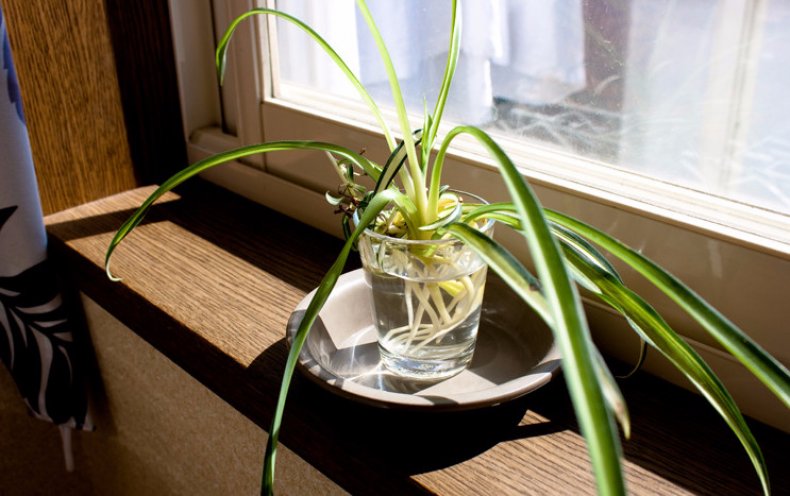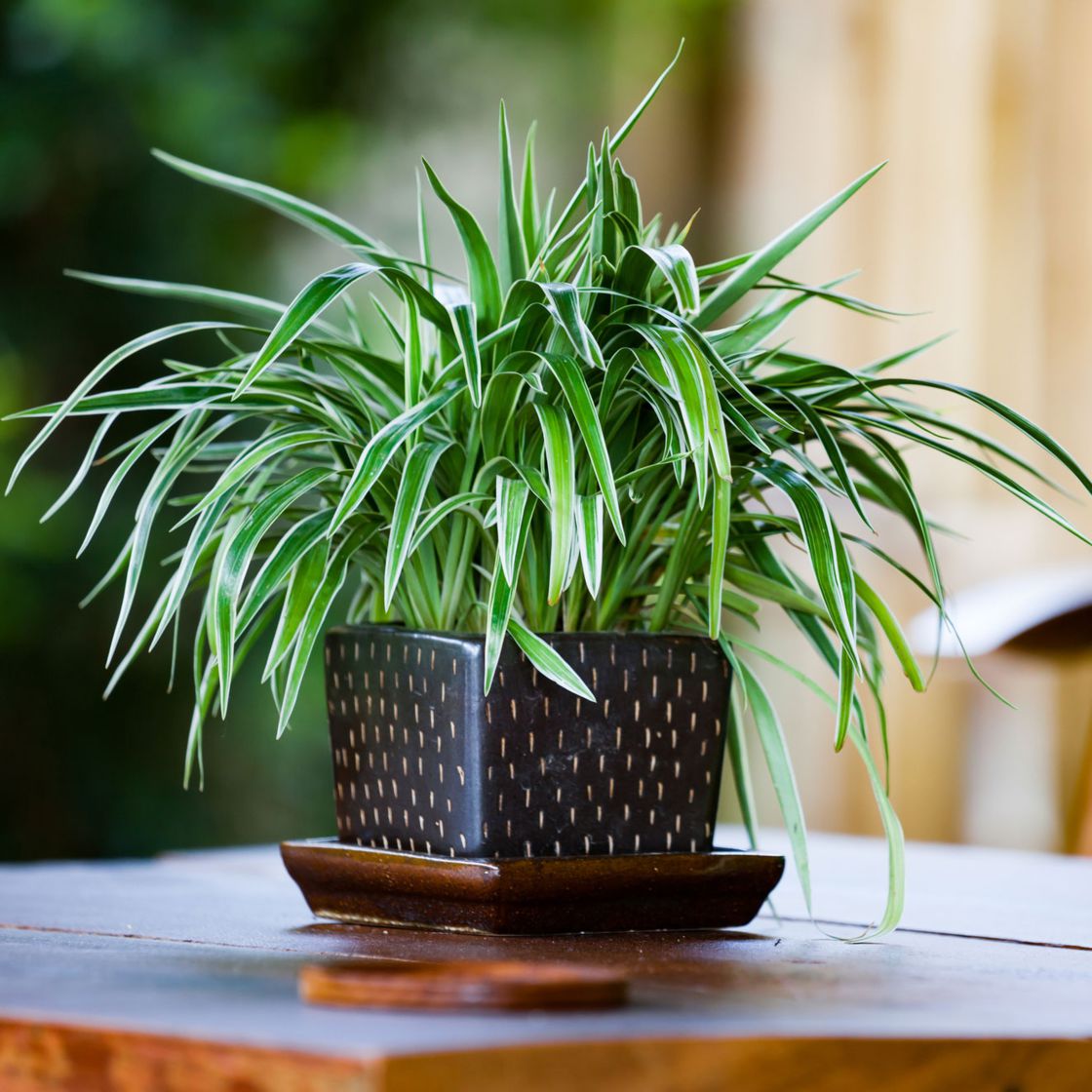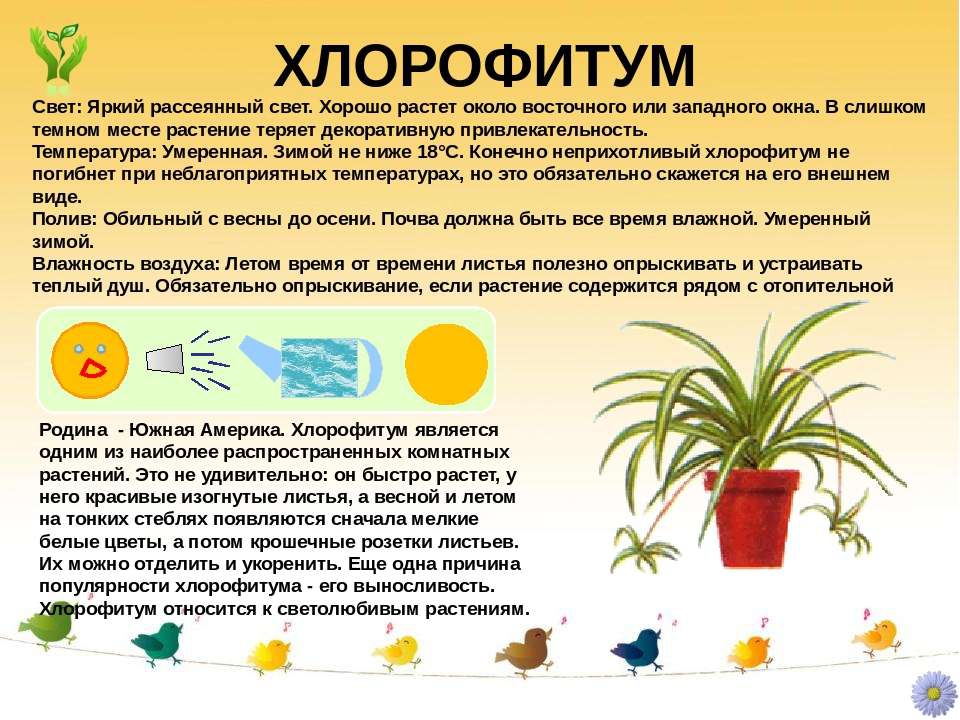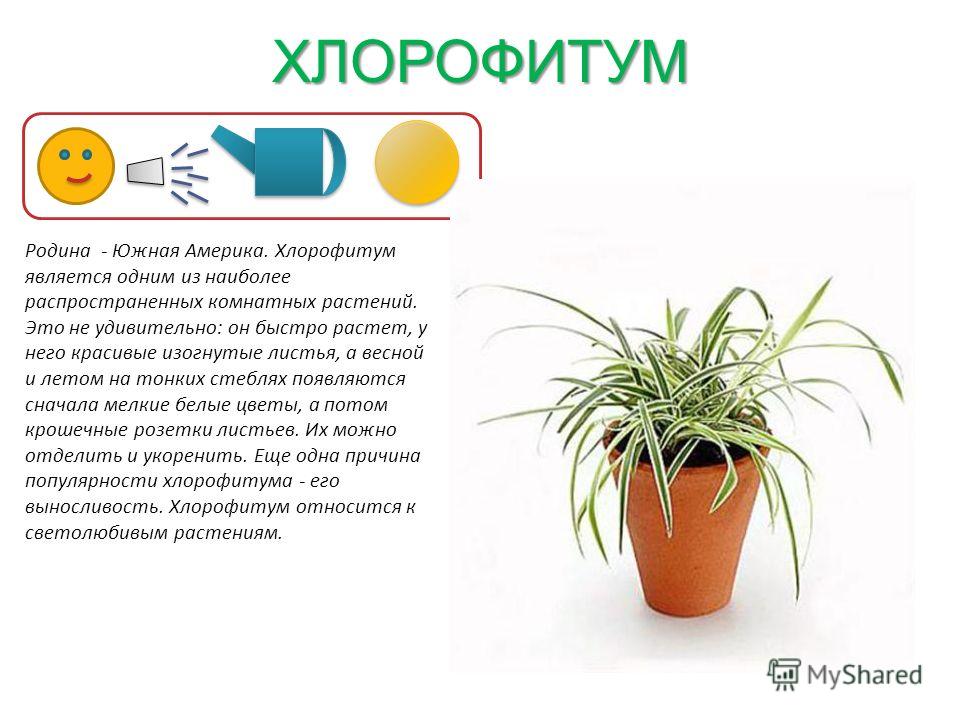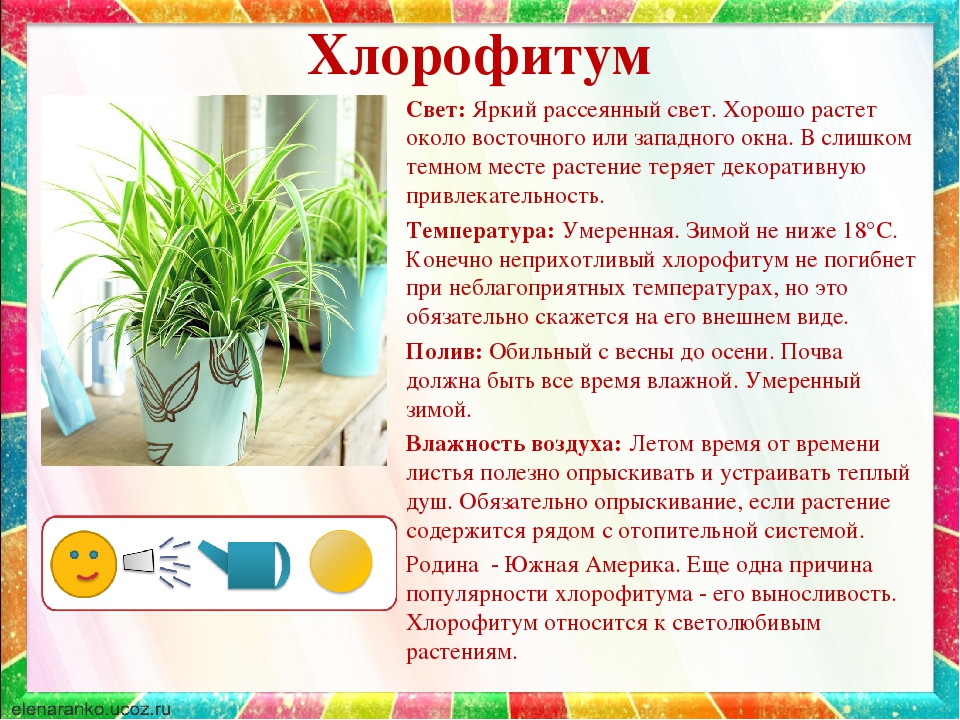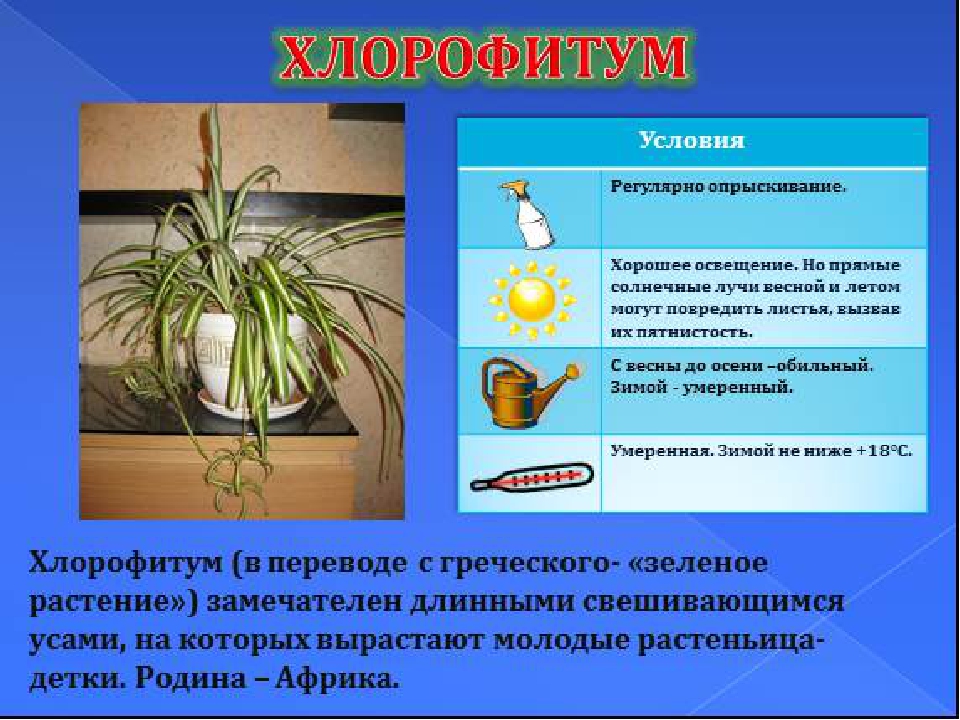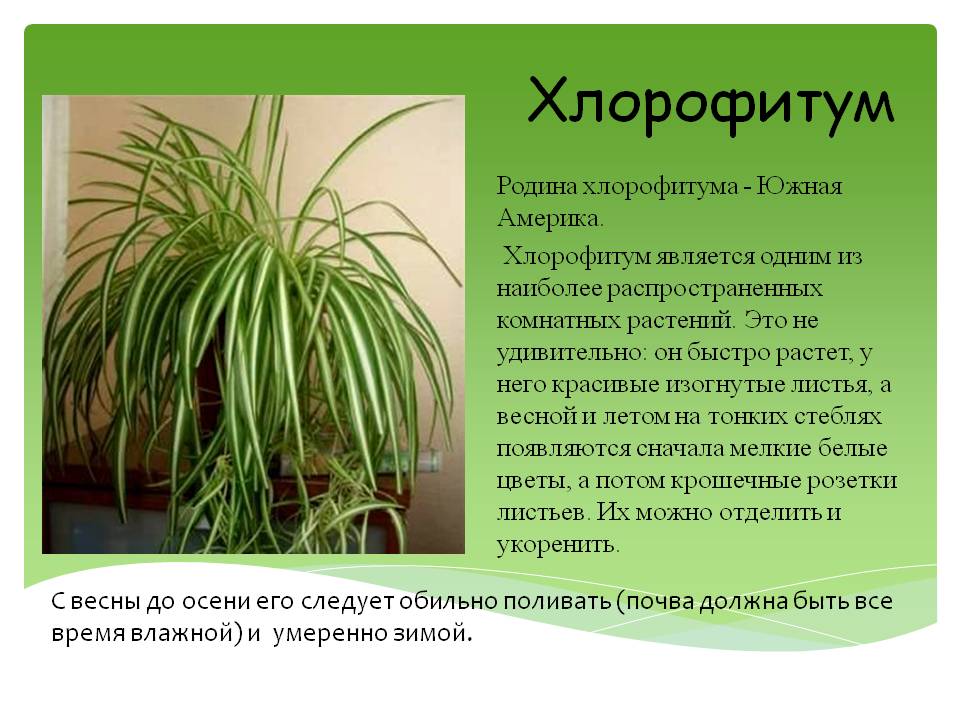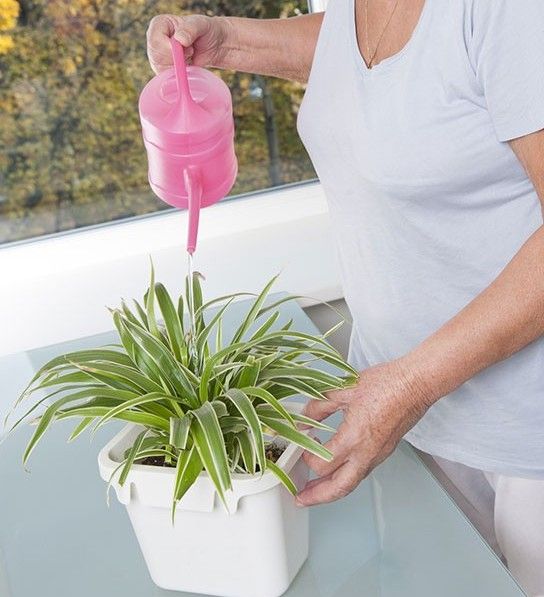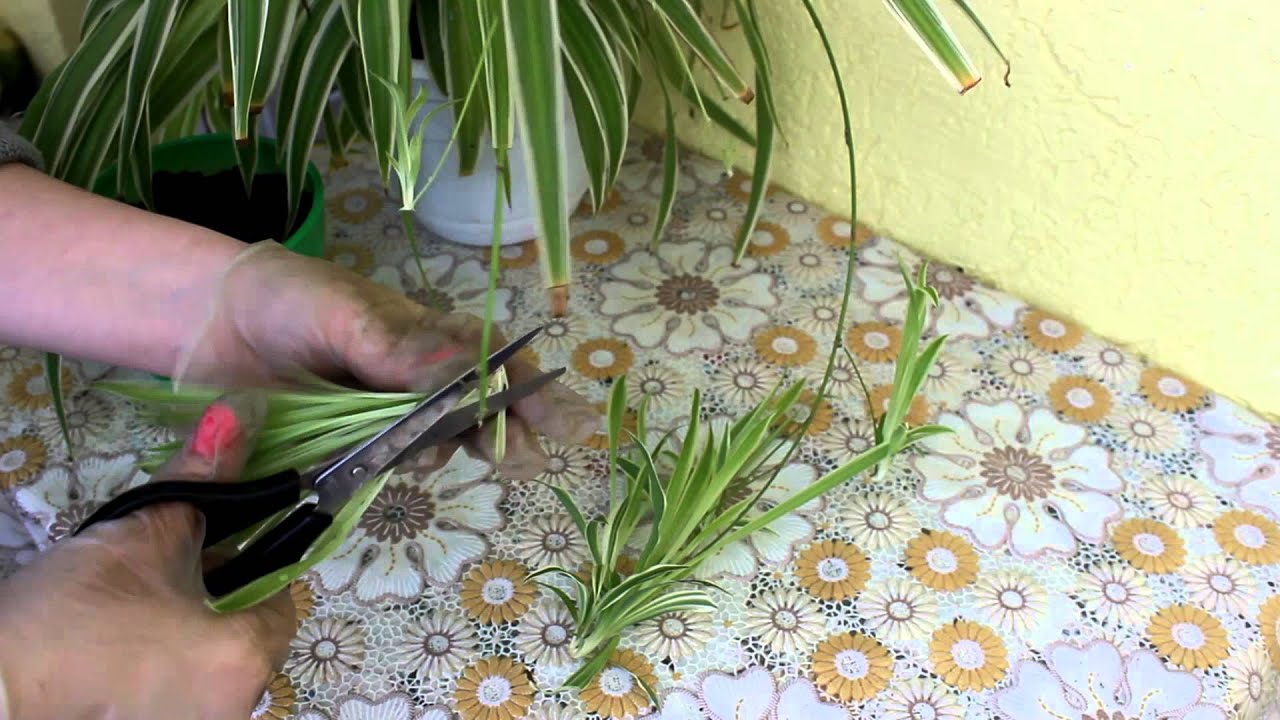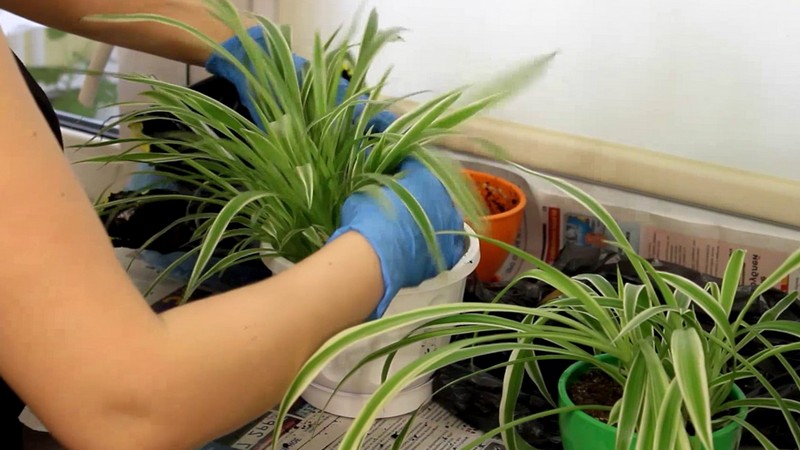Reproduction methods
Chlorophytum can be propagated by dividing the bush, children and seeds. The latter method is rarely used - it is laborious and time-consuming. But seed propagation can be used to grow new varieties. In other cases, it is better to use the vegetative method.
Daughter sockets
Most chlorophytum species form daughter rosettes on long, hairless whiskers. They are already viable plants, which, when placed in a good environment, quickly take root. For reproduction, mature rosettes with roots are chosen.
To build up the roots, the baby is immersed with the base in a container with water with the addition of a root formation stimulator, and left for several days. Then they are planted in light soil, covered with a jar or polyethylene until stable signs of growth appear. The main advantage of this method is that reproduction by children is performed year-round.
By dividing the bush
Divide adult bushes at the age of three years. The method is used mainly for varieties that do not produce a mustache with children. Divide the bush in the spring, simultaneously with the next transplant.
Chlorophytum is preliminarily watered and left for a couple of hours so that the soil is completely saturated. The plant is removed from the pot, the clod of earth is not destroyed. With a sharp, sterile knife, cut the bush into the required number of parts. Dried, softened roots are cut off, all cuts are treated with coal powder and fungicide.
Delenki are planted in separate small pots filled with loose soil with the addition of sand. For several days, they are covered with plastic bags with small holes so that rooting proceeds faster.
Seeds
New hybrid varieties can be grown from seed. It is better to buy seeds in specialized stores. The germination rate even for fresh planting material is 25–40%, so it is better to sow with a margin.
Before sowing, the seeds are wrapped in a cloth, soaked in water with the addition of a few drops of a growth stimulant. The water is changed every four to six hours. The container is filled with a substrate consisting of peat and perlite.
Spread the seeds evenly, lightly press them down, spray the soil with water. The container is covered with foil on top, placed in a warm, shaded place. Until the seeds germinate, maintain a stable temperature at the level of 22–25 ˚С. The container is regularly ventilated, if necessary, slightly moisten the soil with a spray bottle.
Seeds germinate for a long time - at least a month will pass before the shoots appear. After the formation of the first true leaf, the shelter is removed, after the second or third, the seedlings dive into separate containers.
Pruning is only needed to maintain the decorative effect of chlorophytum. Broken, damaged, deformed, dried leaves are cut off. Pruning is carried out with a sharp secateurs. The leaves are cut right at the base of the rosette. Sometimes too long mustaches are shortened to make the bush look neat. The inner part of the rosette is not touched - only the outer leaves are cut off.
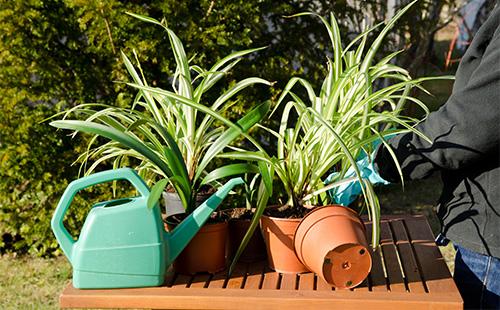
Reproduction methods
Many novice gardeners are wondering how to properly propagate curly chlorophytum. This process is carried out using seeds or rosettes, although often amateur flower growers prefer to simply buy an already grown flower in a store. It has been established that the germination rate of the seeds of this plant is quite small and does not exceed 35%.
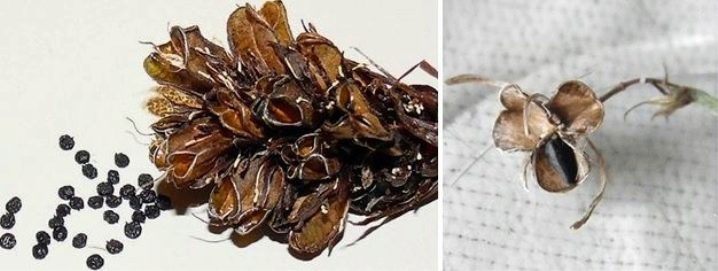
For more promising growth, experts advise soaking the seeds a day before planting.
- After soaking the seeds, they should be sown immediately in a previously prepared and moistened soil.Peat and sand must be present in the soil.
- Then the seeds are lightly pressed, sprinkled with soil and covered with glass. Sometimes you can use hard film. The main thing is not to forget to do airing several times a day.

Reproduction can be carried out using the resulting outlets. Immediately after the plant has faded, so-called rosettes will begin to appear on the arrows, which are used by many gardeners to propagate the plant. For reproduction, the rosette must be cut off and lowered into a glass of water. As soon as the first roots appear, the young plant can be transplanted into a pot with prepared soil.
Growing conditions
Chlorophytum is not picky about lighting. But in order for its leaves to be saturated green and elastic, the plant needs light, but not direct rays, since they can cause significant damage to the flower, and due to an excess of light, the flower's ground will dry out, and the leaves will acquire a pale green color. If the flower stays in the shade for a long time, this is also not a good sign. Due to the lack of light, the leaves of the plant will become brittle and lifeless. To make chlorophytum comfortable, you need to expose it to the sun for 3-4 hours every day, and then put it in the shade. Thus, the plant will not experience a deficit of daylight, as well as an overabundance of it.
But it is also important that the plant is not in the cold, which it does not like. The air temperature in the room where chlorophytum is located should not be lower than +10 degrees
If the plant is constantly surrounded by hot hot air, it will become sick and wither, so the air temperature is very important for the plant. The optimum air temperature is considered, which is in the range of + 17-20 degrees.
Chlorophytum does not need frequent watering. In the summer and during the period of active growth, it must be watered once every 3-4 days. In winter, the plant should be watered no more than once a week. If chlorophytum is over-watered, or watered less than the specified number of times, the plant may rot. Of course, in the summer, with increased dryness of the air, and if the flower is near heating devices, you need to spray it more often. It is necessary to spray and water the plant at the same frequency, but on different days.
Chlorophytum transplant after purchase
Immediately after purchase, chlorophytum should be transplanted into a sufficiently wide pot
Particular attention is paid to the drainage layer at the bottom of the tank. Also, a transplant is required for plants whose roots have made their way through the drainage holes.
This means the chlorophytum needs more volume to take root.
Very young and small plants are transplanted quite often - every year, and this is done just before the arrival of spring, when the flower is preparing for active growth. Then, when the chlorophytum is already growing, the need for a transplant decreases and the pot is changed every couple of years.
For chlorophytum soil, you can use a universal soil with a pH level around 5.5. The main thing is that the earth is sufficiently loose and loose, since the plant's root system needs oxygen for growth and development.
Features of caring for a flower at home
There are no special rules in caring for chlorophytum orange at home, so even amateur flower growers can cope with this.
Temperature
The plant is thermophilic, therefore it does not tolerate a drop in temperature. In summer, the temperature regime should be within 20 ° С, in winter - at least 15 ° С.
Lighting
The plant needs abundant lighting, then the foliage will be more lush and rich green. However, during hot and sunny summer periods, it is worth moving the pot away from windows during the day.
Important! On warm, clear days, it is better to pull the container with a flower out into the street, terrace or open balcony
Watering
The moisture-loving chlorophytum plant requires abundant and regular watering. In the summer, the frequency of watering should be increased. After each watering, it is recommended to loosen the soil so that the water in the ground does not stagnate.
Spraying
Spraying is carried out twice less often than watering. The plant is sprayed with clean water without impurities from a spray bottle. The procedure helps to increase moisture and get rid of accumulated dust and dirt.
Humidity
Tropical winged chlorophytum needs high humidity levels, the level should not drop below 75%. On very dry and hot days, the bushes are sprayed several times a day.
Priming
The soil should be loose and moist. For additional looseness, river sand is added to the planting substrate. For nutrition, fertilizers in the form of humus must be added.
Top dressing
For healthy growth, you need to feed the bush at least once a week. Complex mineral preparations for decorative deciduous plants are used as fertilizers. To achieve lush foliage, you need to increase the nitrogen content of your top dressing or use ammonium nitrate.
Pruning
Pruning is rarely carried out, only when extra lower leaves and rosettes appear. It is also necessary to promptly remove dried and rotten stems and leaves.
Transfer
Chlorophytum grows rather quickly, therefore it requires frequent transplantation. Usually every spring the plant is transplanted into a new container with a large volume. For planting, they purchase a special substrate or prepare it themselves from loose earth, sand and fertilizers. After planting, the bush must be watered abundantly.
Features of caring for indoor flower chlorophytum at home

Chlorophytum is not picky about care. This grateful plant will delight not very attentive owners, if not with flowers, then with year-round greenery.
Location and lighting for the plant
Optimal for chlorophytum will be the location on the east and west windows. If the windows have a southern orientation, it is better to place the plant a little further from window sills and direct sunlight, give preference to shelves, hanging pots.
An adult chlorophytum bush looks decorative as a tapeworm (single plant) and planting in groups. It is better to plant young bushes. Over time, they will grow so as not to overshadow each other. Such a composition will look more harmonious.
Florists and phytodesigners successfully use chlorophytum when creating compositions. Due to the variety of species and varieties, with the help of chlorophytum, you can “play” on the contrast of colors or select other species in a group that are in harmony with the shape of the foliage. Most often, chlorophytum serves as the background or the lower tier of the composition.
Air humidity
Air humidity should be 40-90%. The plant tolerates dry air quite persistently during the heating season. But its development slows down during this period. It is recommended to regularly sprinkle the leaves and periodically wipe them from dust with a soft, damp sponge.
Temperature regime for a flower
Chlorophytum is a subtropical plant. In winter, it can be kept at temperatures as low as + 10-15 C0. The plant tolerates heat well.
How to properly water a flower
Chlorophytum "loves" water. To understand how you water a plant in a specific temperature and humidity, watch your specimen. Pour with settled water at room temperature so that the water completely saturates the clod of earth, and a small part seeps into the pan. The next watering will be necessary when the soil becomes slightly damp, closer to dry, on its surface. It is easy to identify by touch. Frequent surface watering will not satisfy the plant's watering needs, and overflowing can lead to sticking and rotting of the roots and growth point of your chlorophytum. In this case, it is not possible to revive the plant. In the case of chlorophytum, it is better to underfill than overflow, especially in winter.Also, due to excessive watering, long leaves break from weight.
Chlorophytum care at home

There are about 250 varieties of this plant. Flowering occurs, although infrequently, but still this can be expected. Flowers usually appear in March. At the same time, flowering continues throughout the entire growing season. Due to the hanging leaves, chlorophytum looks good on a stand or in a hanging planter. There is not only indoor chlorophytum, but also a garden plant.
Considering the care of chlorophytum at home, first of all, it is worth studying the features of the microclimate, the requirements for the soil and feeding.
Illumination and temperature

The flower will feel good on the windowsill of a window with a western or eastern orientation. He loves bright diffused light, is able to withstand direct sunlight for a short time. However, bushes with variegated leaves require more daylight, since with a lack of it, the leaf plates lose their color.
If the pot is placed on the north window, then due to a lack of light, the leaves will fade, the plant will not bloom and grow layers. Despite this, on the south side, the flower will also feel unwell due to prolonged exposure to direct sunlight.
Chlorophytum tolerates hot and cool indoor air equally well. In summer, the pot can be put outside, choosing a place where precipitation does not fall, and where there are no drafts. In winter, the room should not be colder than 10 degrees, as the plant may die.
Watering and spraying
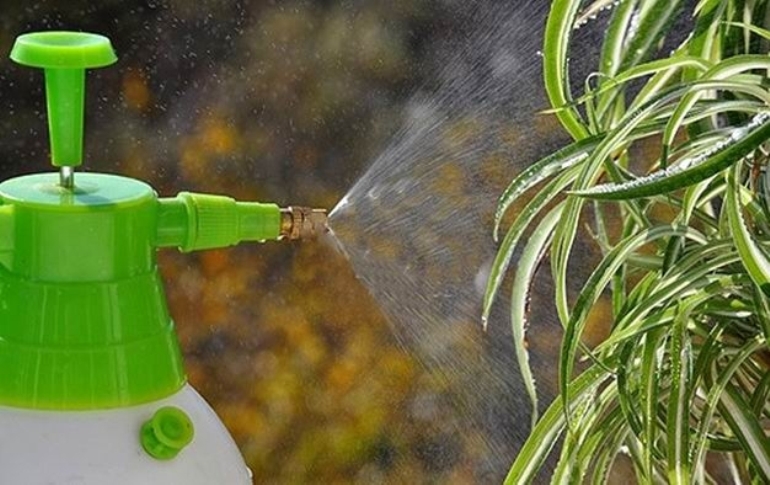
In the warm season, the bush requires a lot of moisture, so it is watered abundantly and often. With insufficient watering in chlorophytum, the process of forming a tuberous thickening starts. In winter, the abundance of watering is reduced, but the earthen lump in the pot is monitored. Do not allow it to dry out. There must be drainage in the pot, and after watering, the water is drained from the pan to eliminate moisture stagnation and subsequent root decay.
In principle, there is no need for regular spraying. The flower will feel good even without it, because it does not need high humidity. However, if spraying is nevertheless carried out, it will intensively grow and develop, as well as delight the owners with beauty and splendor.
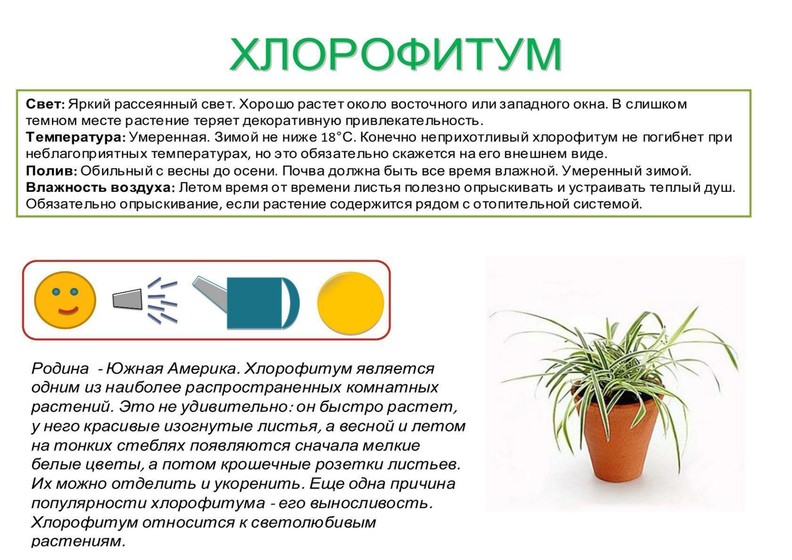
Chlorophytum fertilization
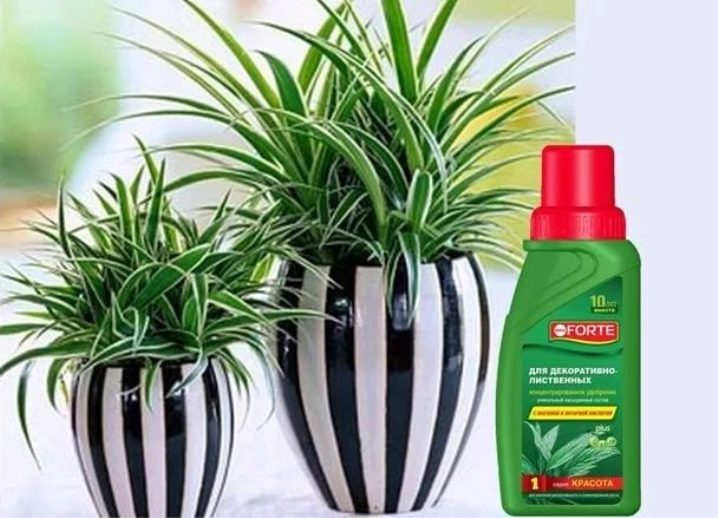
Top dressing is carried out in spring and summer 2 times a month. At the same time, mineral and organic fertilizers alternate. It is also allowed to use combined formulations that are intended for fertilizing ornamental deciduous plants.
Soil composition for a flower

The plant grows well and develops in a substrate of the following composition:
- river sand - 1 part;
- derain - 2 parts;
- leaf land - the same amount;
- humus - 2 servings.
There must be drainage holes at the bottom of the pot. In addition to them, a 2 cm high drainage layer is made from expanded clay, broken brick or pieces of foam. A wide, deep pot is suitable for chlorophytum. When using special mixtures for decorative deciduous flowers, the bush does not need additional feeding during one season.
Some useful information about the types of chlorophytum
The chlorophytum family is huge and includes several hundred species. Only a few varieties are used for growing at home, but don't let that confuse you, they are so beautiful and diverse. That will perfectly embellish any room.
Among the chlorophytums grown at home, the following types are especially popular:
- Curly (handsome with twisted leaves, each of which has a wide white stripe - the main decoration of the bush);
- Crested (resembles curly, especially due to the light stripe, but the leaves are not so wrapped, and are longer);
- Cape (simple leaves, no stripes, unlike most types of chlorophytum that release children, this species reproduces by dividing an adult bush);
- Laxum (a very rare variety, has stripes only along the edges of long leaves, is rather difficult to breed, since it does not form children);
- Orange (popular due to the picturesque leaves - emerald green, located on orange roots, the peduncle at the end of flowering resembles an ear of corn, which is unusual and very beautiful in combination with the leaves of a chic shade).

Features of the maintenance and care of chlorophytum
Proper care of chlorophytum involves several factors: lighting, watering and feeding, pruning, and disease control.
Lighting and temperature control
Chlorophytum feels great in any light
It is important to remember that direct light dries out the ground and leads to pallor of the leaves, but if you put the plant in the shade, this will lead to fading of the leaves. Due to poor lighting, the leaves of chlorophytum begin to break.

It is best to put the plant in the sun for 3-4 hours a day and then put it in the shade.
When choosing a temperature, the main thing is to prevent hypothermia of the plant. The temperature should not be lower than 10 ° C. Constant heat will also have a negative effect on the state of chlorophytum. The optimum temperature for this plant is + 18 ° С.
Watering and humidity
In this section, we will discuss how to properly spray and water chlorophytum.
In hot periods of the year or active growth, the main thing is to take care of abundant watering of chlorophytum, about once every 2-4 days.
In winter, watering should be reduced, once a week will be enough.
Failure to comply with these rules leads to root rot.
If you have dry air in your house, then you will need to spray the leaves of the plant regularly, in any season. And the hotter, the more often this procedure should be carried out, it also depends on the time of year and the presence of batteries and heating devices nearby. Spraying and watering are carried out on different days, but with the same frequency.
Fertilizing and fertilizing the soil
The best time to feed chlorophytum is from April to September. If you have an ornamental plant, fertilization is done twice a month. It is better to fertilize with complex fertilizers, and no more than once a month to water the plant with sweetened water. To do this, dilute a teaspoon of sugar in one liter of water.
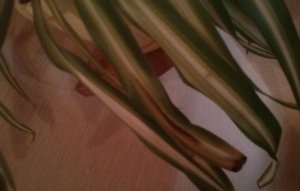
Many gardeners are wondering why chlorophytum leaves dry, and there is an answer to this. This means that the plant should be fed weekly with all the necessary nutrients.
In addition, fertilization ensures the growth of chlorophytum and the formation of new children.
Did you know?
Chlorophytum alone is sufficient to reduce the effects of nitrogen oxides in a gas-burning kitchen.
Transplanting and pruning plants
In this section, we'll tell you when to transplant chlorophytum and how to prune.
It is impossible to grow a gorgeous bush of a plant if you do not transplant it at least once.
There are several reasons when a plant needs to be transplanted:
1. Small pot;
2. Depletion of the soil.
In order to properly transplant the plant, you should prepare a flower pot that will be several centimeters larger in diameter than the previous one, new soil and chlorophytum itself.
There are the following stages of transplantation:
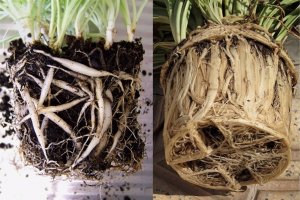
- To begin with, you should loosen the earthen mixture in the pot so as not to damage the root system of the plant when you take it out. The plastic pot can be wrinkled by hand.
- After the bush has been removed from the pot, the root system of the plant should be carefully straightened, because it takes the shape of the previous pot. It is also necessary to remove excess soil from the roots.
- Then the bush is moved to the selected pot with the renewed soil.
- After planting, water the chlorophytum.
how to renew chlorophytum and when. pruning.
Important! Do not cut into green living tissue.
If the tips of the leaves are brown, cut them just above the edge of a healthy leaf.
Chlorophytum photo






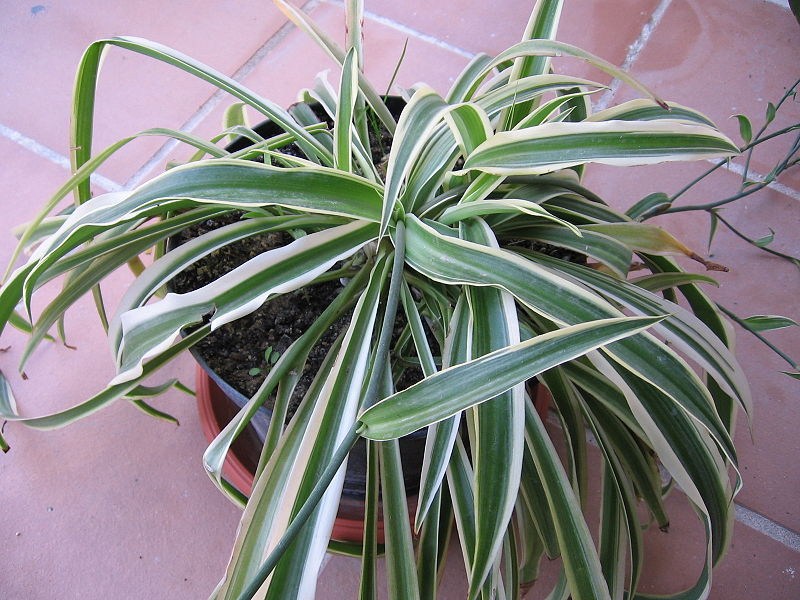





















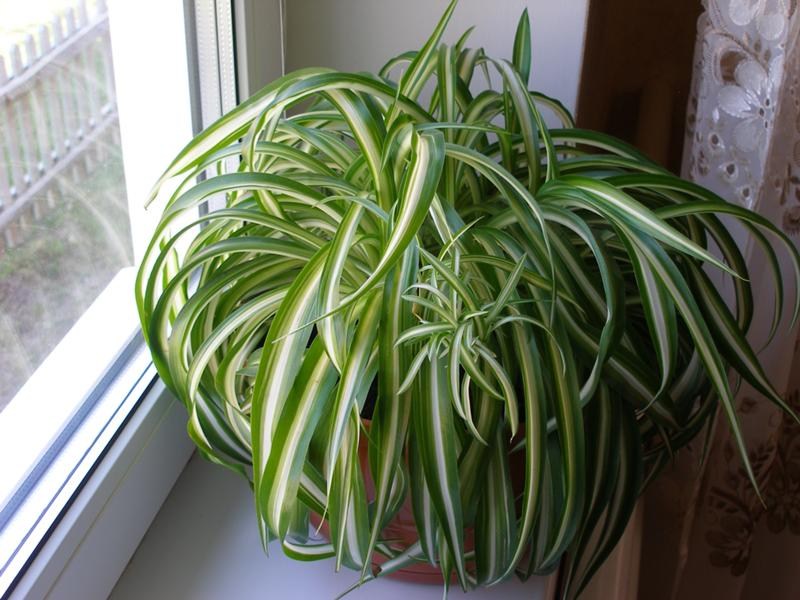










We also recommend viewing:
- Dracaena
- Araucaria
- Alocasia
- Cyperus
- Maidenhair
- Hypoestes
- Aspidistra
- Indian bow
- Cordilina
- Date palm
- Hamedorea
- Irezine
- Radermacher
- Asplenium
- Rivina
- Soleirolia
- Sansevieria
- Nertera
- Arrowroot
- Aglaonema
- Heliconia
- Nephrolepis
- Ophiopogon
- Amorphophallus
- Plectrantus
- Calathea
- Yucca
- Tsikas
- Cardamom
- Stromant
- Selaginella
- Rosemary
- Ktenanta
- Caladium
- Asparagus
- Fittonia
- Reo
- Sheflera
- Ginura
Main features, useful properties

The option under consideration has many proven benefits. It is easy to recognize by linear leaves up to 80 cm long, most often there is a white border along the edge. There are different varieties, it is easy to highlight the main features:
- In its natural environment, it grows in the subtropics of South America, South Africa. In nature, the height and width reach a meter.
- The leaves are collected in a bunch or rosette, directed upwards, but bend, and then go down as they grow. In indoor conditions, the height does not exceed 40 cm.
- Flowers are formed on long arcuate stems. After flowering, rosettes with roots are formed at the ends, because of which Chlorophytum is often called a spider plant.
- On the roots there are tuberous thickenings in which water accumulates. Therefore, it goes through periods of drought normally, uses its own moisture reserves.
Advice! The plant feels very good in a flower pot, leaves and stolons hang down, decorating the room.
It's easier to buy for the first time, not multiply. It is better to experiment later, when there are shoots. A small bush will grow in literally a month or two, if you provide a suitable microclimate, as well as observe the watering regime.

This option is recommended to grow at home, not only because of its beautiful appearance and good omens. It has many proven benefits that can help improve the microclimate in your home. It is especially useful for city apartments. The main advantages are:
- The leaves absorb toxins, formaldehydes, carbon monoxide, and other harmful compounds from the air.
- Saturate the air in the room with oxygen, emit phytoncides that destroy pathogenic bacteria.
- They kill about 80% of all harmful microorganisms in an area of about 2 square meters. 4 plants purify the air in a room with an area of 10 sq. M.
- They absorb electromagnetic radiation from household appliances, so they grow normally even in the kitchen. Such influences do not harm Chlorophytum.
- They get along especially well with geraniums. They suck up house dust, kill harmful bacteria.
- Maintain normal air humidity by absorbing excess water or releasing it if the room is dry. Very useful for those with allergies.
The best effect is achieved at a distance of a meter from all sides, set so as to sit near the flower. It is best to place it near the places where the family spends the most time, then the benefit will be maximum.
Chlorophytum content temperature
A sharp cold snap or warming, the flower does not tolerate. The temperature for it should be 18-20 degrees. In the summer, he needs abundant watering, and in the winter, moderate. You also need to protect chlorophytum from sunlight. West and east windows work best.
The plant needs enough water, dry leaves in a plant signal poor care, many people think that this is due to negative energy in the house
But do not make hasty conclusions, first of all you need to pay attention to caring for the plant. In the warm season, feed with liquid fertilizers, spray it with water so that it does not dry out
If you have a young plant, you need to replant once a year in February or March. An adult flower needs to be transplanted twice a year. If you follow these tips at home, you will have luxurious chlorophytum.With this flower you can make interior decor. It has a positive effect on human health, cleans the air in the room. It also helps with depression, relieves stress. If there is chlorophytum in the house, peace and quiet reign there, protecting household members from bad, negative energy. This amulet is for a person who will bring good luck and happiness.
Common mistakes made by florists
Improper watering, inappropriate place, too dry air - these and some other factors reduce the decorative effect of chlorophytum. To correct errors of leaving and prevent them again, study the table.
Table - Common mistakes in chlorophytum care
| External manifestation | The source of the problem | Helping the plant |
|---|---|---|
| Chlorophytum dries up | - Weak watering; - small volume of the pot; - damage by pests |
- Transplanted into a larger pot; - watered regularly; - inspected for the presence of pests, if necessary, treated with an insecticide |
| Chlorophytum does not bloom | - Insufficient age for flowering; - large pot |
- Follow the recommended care regimen |
| The tips of the leaves dry | - Low humidity | - Spray regularly; - increase humidity by any means |
| Leaves lose their firmness | - Cold; - excess nutrients |
- Top dressing is suspended; - chlorophytum is transferred to heat |
| Chlorophytum turns yellow | - Heat; - poor lighting; - stagnant moisture in the root area |
- Rearranged to a cooler place; - check the roots and regulate the irrigation regime; - install additional lighting |
| Leaves lose their variegated color | - Lack of light | - Rearranged closer to the window or install additional lighting |
| Leaves turn black | - Combination of cold and excess water; - heavy clay soil |
- Chlorophytum is transplanted with the removal of damaged leaves and roots; - watered moderately until the plant recovers |
| The tips of the leaves turn brown | - Lack of trace elements; - dry air; - heat; - sunburn |
- Eliminate all possible causes |
| Leaves wrinkle, edges turn brown | - Lack of moisture | - Water and spray regularly |
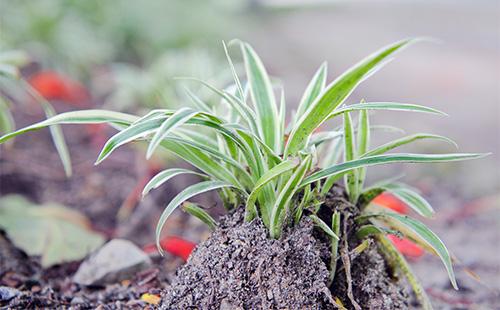
Chlorophytum, pets and children
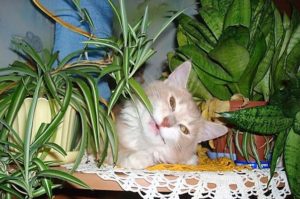
If you have a cat, then it will most likely gnaw on the long, succulent leaves of chlorophytum. This should not be allowed - after all, the plant sap is conventionally poisonous for cats. These creatures usually gnaw on the leaves of all saber-like plants in order to induce a gag reflex when it becomes necessary to empty the stomach of wool accumulated there. But, it is better to place the flower in places inaccessible to the animal or, in general, to abandon it in favor of others, no less attractive, but safe for your pet.
By the way, chlorophytums are also set aside from small children further and higher so that they do not hurt their palms by grasping the sharp saber-shaped leaf of the plant and dragging it into their mouth.
We advise you to pay attention to this unpretentious but charming guest from the tropics. We are sure that you will make friends and find a common language
Chlorophytum will gladly adorn the interior of your home, and for many years, day after day, it will delight your household and guests with its unusual and attractive appearance.
Transplant and alternative to soil
Chlorophytum roots have a rather dense structure. Each root is elastic and wide; it has an oblong tuber. In just a year of life, the root system grows significantly, tightly braiding an earthen ball and occupying the entire planting capacity. If the plant is not transplanted in time, it will stop developing and stop growing.
 Photo chlorophytum
Photo chlorophytum
It is very easy to carry out a transplant, for this you need to follow a number of sequential steps:
Water the plant well. The moisture will be completely absorbed into the earthen lump and soften it
The roots can be gently removed from the pot without damaging them.
The plant is transferred to a dry newspaper and carefully straighten all the roots, touching them with your fingers.
When the roots are straightened and cleaned of the old soil, the bush is placed in a pot with new soil and watered.
If there is no large capacity at the moment, the bush is divided into several parts with a sharp knife (along with the roots) and seated in several small containers.
Chlorophytums do not need any special soil mixtures. It is enough that the earth is just nutritious and light. It is best to mix in equal proportions turf and leafy soil with river sand and humus. Purchased soil is recommended to select light with an acidity index in the range of 6 - 7.5 pH.
If it is not possible to use the earth, pay attention to the hydrogel. This method of growing is suitable for young plants, as they adapt to new conditions much faster.
The roots are pre-cleaned of earth residues and washed
The hydrogel is moistened very carefully: fresh water is added little by little and not often. In such an environment, chlorophytums are grown in shade, periodically feeding with a weak solution of fertilizers.
So that the hydrogel balls do not stagnate and do not have a musty odor, they are washed under running water.
 Photo chlorophytum
Photo chlorophytum
In small apartments, chlorophytums are kept in florariums, they are quite compact and it is easy to maintain the desired microclimate in them.
How to propagate chlorophytum
The simplest breeding methods are by children and by dividing the bush. The seed method is the most laborious and rarely used.
Germinating seeds
Seed germination rate is about 30%. They are sown in spring, pre-soaking in gauze for a day. The seeds should be planted in a sandy-peat substrate, 5-7 mm deep. Then cover with foil. The greenhouse should be placed in a bright and warm place, where the temperature is 22-25 ° C). The film is opened daily to ventilate and moisten the soil from the spray bottle. Seedlings will appear in 4-6 weeks.
Seedlings are opened gradually. At first, for half an hour a day, gradually increasing the time interval. Seedlings should be planted in individual pots in the phase of 2-3 true leaves.
Rooting cuttings
In the spring, they traditionally try to transplant the flower into larger pots, and the overgrown bushes are divided into 2-3 parts. It is necessary to remove the plant from the pot, shake off the soil from the roots. Next, cut the root ball in half with a sharp knife, sprinkling the cut with crushed activated carbon. Each cut is planted in a separate pot with fresh substrate. Watering is recommended to be resumed only after a day.
For your information! Excess plots can be planted in open ground at the end of May, decorating the flower garden.
Air layering
A baby suitable for transplant is about 6-7 cm in size. Usually by this time it has several air roots. The rosette is cut from the peduncle and planted in a pot with a loose substrate. No greenhouse needed. They are looked after in the same way as for adult plants. To grow the roots, you can hold the shoot in a glass of water for some time.
 Planting baby chlorophytum should not be difficult.
Planting baby chlorophytum should not be difficult.
It is perfectly acceptable to root the rosettes without separating them from the peduncle, simply by placing a small pot next to a large one. As soon as the young leaves begin to grow, the peduncle can be cut off.
Possible growing problems and diseases
It is extremely rare for chlorophytum to cause concern to the owner if all the recommended agricultural techniques are followed.
- Drops buds and leaves. This happens due to a lack of food. This means the pot has become too cramped, and it's time to transplant the plant into a more spacious container.
- The leaves turn pale. This happens due to the excess and lack of light, as well as due to the lack of nutrients in a cramped pot. It is necessary to transplant the flower and rearrange it to a more suitable place with diffused but bright enough light.
- The tips of the leaves dry. This is the first signal that the room is too hot.At such a time, chlorophytum needs to be sprayed, and it is also bathed under the shower under a weak pressure of water so as not to break fragile leaves.
- The lower leaves fall off. This is the natural process of growing a rosette. Dry leaves must be carefully removed. If too many leaves dry out, then it's time for a transplant.
Pests
The greatest damage to the plant can be caused by:
- mealybug. Its appearance is signaled by a white, very similar to cotton wool, bloom on the leaves. They fight against the pest of actara, biotlin. Treatments are carried out after 7 days 2-3 times;
- aphid. She is attracted by tender young leaves. The appearance of aphids is signaled by twisted dried leaves in the center of the rosettes. It is recommended to treat the plant with actellik three times with an interval of 7 days;
- nematode is a very dangerous root pest. Only heat treatment will help to get rid of it. The flower is removed from the soil and the roots are washed with water at a temperature of 50-55 ° C for at least 15 minutes. Then they are planted in a clean pot with new soil.
Other problems
Juicy and fragile leaves are very fond of eating cats. Therefore, the pot should be hung higher in the planter.
Rolled leaves with brown or even black spots are a sign of sunburn. The pot should be rearranged to another, slightly shaded place. Too high air temperature and lack of water have the same consequences for foliage.
A bush littered to one side is another symptom showing that it is time to transplant the flower. When the overgrown chlorophytum is drawn to the light source, it can fall sideways under its own weight.
Common growing problems
Chlorophytum is an unpretentious plant. Sometimes you have to face a number of problems, but they can be easily eliminated by adjusting the care.
- Blackening of the tips of the leaves. He talks about excessive watering. It is recommended to reduce their frequency and intensity.
- Yellowing of the plant. The point is insufficient lighting or a cramped pot. The plant is transplanted and placed in a well-lit place.
- Slow growth. When planted in a pot that is too large, the plant puts all its energy into the development of the root system. The growth of the aerial part slows down. The second possible reason is heavy ground. The plant is transplanted into a smaller pot using light, nutritious soil.
- Lack of children. Children do not develop with a lack of light and the use of cramped pots.
- Lack of flowering. Too nutritious soil, excessive feeding. Transplanting into less nutrient-rich soil will help. Top dressing is temporarily stopped.
- Brittle leaves. This is caused by an excess of fertilizer and a lack of light. Top dressing is stopped, the flower is rearranged to the south window.
- Rolling leaves. Speaks about a lack of minerals.
- Spider mites and aphids. From a spider mite, the plant is treated with acaricide. Aphid treatment is carried out manually - the affected leaves are cleaned with a sponge dipped in soapy water.
Chlorophytum is beautiful, not capricious, it cleans the air in the apartment. This is the best choice for novice florists.


